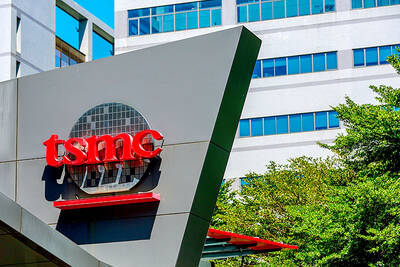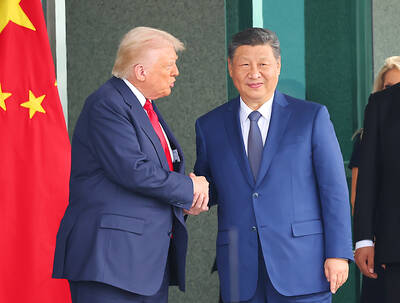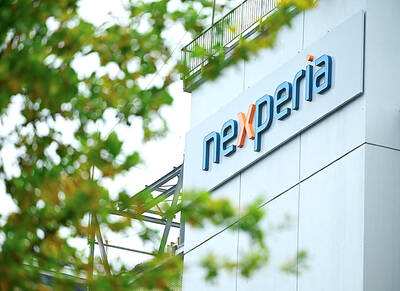Smartphone maker HTC Corp (宏達電) yesterday launched its first 4G entry-level smartphone in the domestic market, with an eye to seizing 25 percent of the low-price market segment this year.
HTC has previously resisted entering this market, and its market share has dwindled as more affordable models prevailed over premium ones.
The firm had never launched a 4G smartphone priced at about NT$5,000 (US$158.42) in Taiwan before, HTC North Asia president Jack Tong (董俊良) said, but it is hopeful that the new handset can help it reach its goal of selling more than 375,000 4G and 3G entry-level smartphones in the nation this year.

Photo: Wu Pei-hua, Taipei Times
That translates into about a quarter of the nation’s low-price smartphone market of 1.5 million units this year, Tong said.
“Following our success in selling the mid-range smartphone Desire 816 and partnerships with local telecom operators and retailers, we believe that our new entry-level 4G model has a chance to help us achieve our sales goal,” Tong told reporters on the sidelines of the HTC Desire 626 product launch.
Tong said the 5-inch Desire 626, priced at NT$5,990, has a 13-megapixel rear camera and 5-megapixel front camera that should attract budget-conscious young users who like to take selfies.
While the company on Friday told an investors’ conference call that revenues this quarter are expected to fall by between 6.05 percent and 13.36 percent sequentially due to a slow season, Tong said that in its home market, HTC should be able to maintain double-digit percentage growth.
“The first-quarter performance in Taiwan will be very impressive, driven by our full range of smartphones and revenues from direct stores,” Tong said, adding that robust sales of HTC’s action camera RE should also boost revenues this quarter.
He said the company would evaluate the sales performance and popularity of the HTC RE in Taiwan before making a decision on launching another new non-smartphone product.
In related news, South Korea’s Samsung Electronics Co yesterday also launched new mid-tier smartphones in Taiwan.
Andy Tu (杜偉昱), general manager of Samsung Electronics Taiwan’s information technology and mobile communication team, said the latest Galaxy E7 is the company’s first mid-tier model to feature a 5.5-inch display and priced at NT$9,990 in Taiwan.
“As smartphones priced under NT$10,000 accounted for 52 percent of the market share last year, we expect the market share of mid-end smartphones to continue to grow this year,” Tu told reporters at the product launch.
The company also launched two other lower-end smartphones — the Galaxy E5 and the Galaxy Grand Max — in Taiwan.
The 5.25-inch display Galaxy Grand Max is priced at NT$7,790, while the price of the 5-inch Galaxy E5 will be announced at a later date, Samsung said.

RUN IT BACK: A succesful first project working with hyperscalers to design chips encouraged MediaTek to start a second project, aiming to hit stride in 2028 MediaTek Inc (聯發科), the world’s biggest smartphone chip supplier, yesterday said it is engaging a second hyperscaler to help design artificial intelligence (AI) accelerators used in data centers following a similar project expected to generate revenue streams soon. The first AI accelerator project is to bring in US$1 billion revenue next year and several billion US dollars more in 2027, MediaTek chief executive officer Rick Tsai (蔡力行) told a virtual investor conference yesterday. The second AI accelerator project is expected to contribute to revenue beginning in 2028, Tsai said. MediaTek yesterday raised its revenue forecast for the global AI accelerator used

Taiwan Semiconductor Manufacturing Co (TSMC, 台積電) has secured three construction permits for its plan to build a state-of-the-art A14 wafer fab in Taichung, and is likely to start construction soon, the Central Taiwan Science Park Bureau said yesterday. Speaking with CNA, Wang Chun-chieh (王俊傑), deputy director general of the science park bureau, said the world’s largest contract chipmaker has received three construction permits — one to build a fab to roll out sophisticated chips, another to build a central utility plant to provide water and electricity for the facility and the other to build three office buildings. With the three permits, TSMC

TEMPORARY TRUCE: China has made concessions to ease rare earth trade controls, among others, while Washington holds fire on a 100% tariff on all Chinese goods China is effectively suspending implementation of additional export controls on rare earth metals and terminating investigations targeting US companies in the semiconductor supply chain, the White House announced. The White House on Saturday issued a fact sheet outlining some details of the trade pact agreed to earlier in the week by US President Donald Trump and Chinese President Xi Jinping (習近平) that aimed to ease tensions between the world’s two largest economies. Under the deal, China is to issue general licenses valid for exports of rare earths, gallium, germanium, antimony and graphite “for the benefit of US end users and their suppliers

Dutch chipmaker Nexperia BV’s China unit yesterday said that it had established sufficient inventories of finished goods and works-in-progress, and that its supply chain remained secure and stable after its parent halted wafer supplies. The Dutch company suspended supplies of wafers to its Chinese assembly plant a week ago, calling it “a direct consequence of the local management’s recent failure to comply with the agreed contractual payment terms,” Reuters reported on Friday last week. Its China unit called Nexperia’s suspension “unilateral” and “extremely irresponsible,” adding that the Dutch parent’s claim about contractual payment was “misleading and highly deceptive,” according to a statement